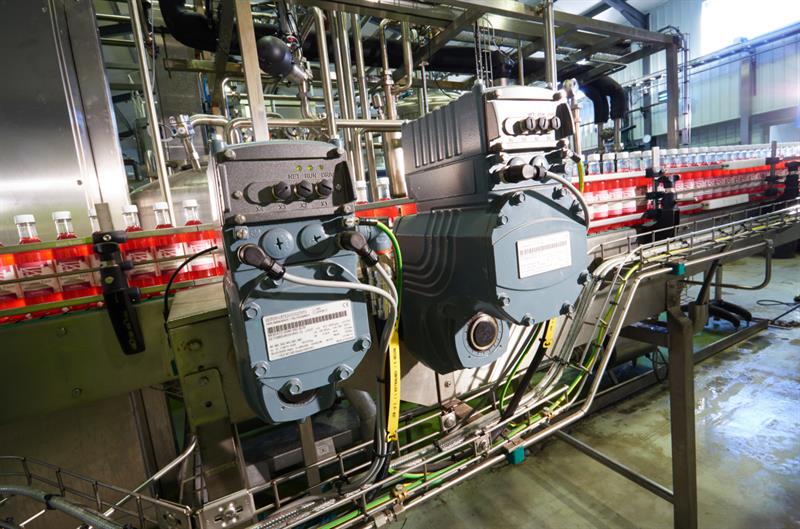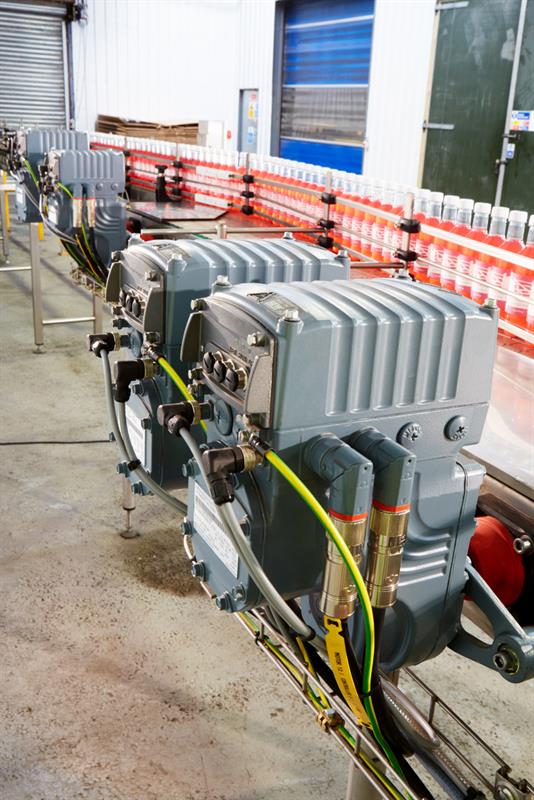Drinks manufacturer, Radnor Hills, has installed a an energy efficient drives solution on a new bottling line that will help the company increase production from 175 million to around 300 million bottles annually, as part of a planned expansion program during its 25 anniversary year.
Based at the picturesque Heartsease Farm, nestling in the beautiful mountains and forests of Radnorshire, Radnor Hills produce a wide range of products in glass and plastic bottles including still water, sparkling and flavoured water, mixers, premium presses, healthy childrens' products and sports drinks.
The new bottling line, capable of handling 22,000 bottles an hour, was designed by factory automation engineers Newberry Systems who worked closely with SEW Eurodrive to utilise the company's mechatronic drive solution Movigear. Limited local power supply issues, as well as Radnor Hills' approach to efficiency and green production dictated the need for an energy efficient solution.
Rather than opting for a continuous supply of empty plastic bottles delivered by lorry for filling, Radnor Hills took the decision to bring PET bottle blowing in-house for the new line. This would have numerous production, cost, and quality benefits, as well as being good for the local environment by reducing traffic to Heartsease Farm.
 However, because of the limited local power supply issues, the increased power required for the blow moulding machine meant that there were limits on the power available to the drive system. With Radnor Hills in such a rural location there was literally only so much power available for the new line.
However, because of the limited local power supply issues, the increased power required for the blow moulding machine meant that there were limits on the power available to the drive system. With Radnor Hills in such a rural location there was literally only so much power available for the new line.
By using SEW Eurodrive's decentralised mechatronic drive technology, Movigear, it was calculated that the energy efficiency of the new drive system would more than compensate for the power requirements of the blow moulding machine and allow the project to go ahead.
Movigear, claim SEW Eurodrive, is typically able to reduce energy consumption by up to 50%, or more, compared to standard drive products. It is designed with high-efficiency individual components and combines the gearing, motor and drive electronics in a single unit. This makes it possible to do away with control cabinets, saving space, reducing costs and the time-consuming wiring of motors, sensors and actuators, not to mention the elimination of much of the costly cabling.
William Watkins, managing director of Radnor Hills said: 'Movigear gave us the opportunity to significantly reduce energy costs, and, given our limited local power supply issues, we may have not been able to go ahead with the new line without it.
'It was a big step to put our faith in a decentralised drive system, rather than opting for a traditional centralised design that our engineers would have been more familiar with. However, it has paid huge dividends not just in energy savings, but in terms of reduced design and installation costs, the flexibility it gives us, and the reduction in cabling and other components.'
The benefits in addition to energy savings have been significant. For instance, with Movigear power supply and communications are handled using Single Line Network Installation technology (SNI). This allows energy and communication transfer in a single four-core cable, which decreases the number of components required, reduces installation costs and provides a clear overview of the various lines, as each unit is simply daisy-chained to the next.
 With SNI technology, the 415V power line is also used to transfer communication signals. A four-core cable (3x phase, 1x PE), between the drives is sufficient. There is no need for separate cables for bus communication and 24V supply. This uses less cabling than a traditional centralised installation and typically reduces the cabling workload by around 60%.
With SNI technology, the 415V power line is also used to transfer communication signals. A four-core cable (3x phase, 1x PE), between the drives is sufficient. There is no need for separate cables for bus communication and 24V supply. This uses less cabling than a traditional centralised installation and typically reduces the cabling workload by around 60%.
According to Rob Newberry, managing directory of Newberry Systems: “This SNI technology cut our field and panel wiring time from what would have taken six or seven days, with a centralised system, to just one.”
A good example of this simplified installation and flexibility came during installation when an additional feature was requested by Radnor Hills' production team that required a new sensor to be fitted on the line. After fitting the sensor all that had to be done was to plug a cable into the I/O on the nearest motor, which was a ten minute job.
With a centralised system a cable would have had to be run all the way round the factory to a PLC in one of the control cabinets, which would have taken about six hours, given the location of the sensor on the line. All in all Newberry estimates that by using Movigear they were able to cut cabling requirements from over a kilometre to just under 200 metres.
Author profile:
Mike Kingsley is electronics manager SEW Eurodrives





